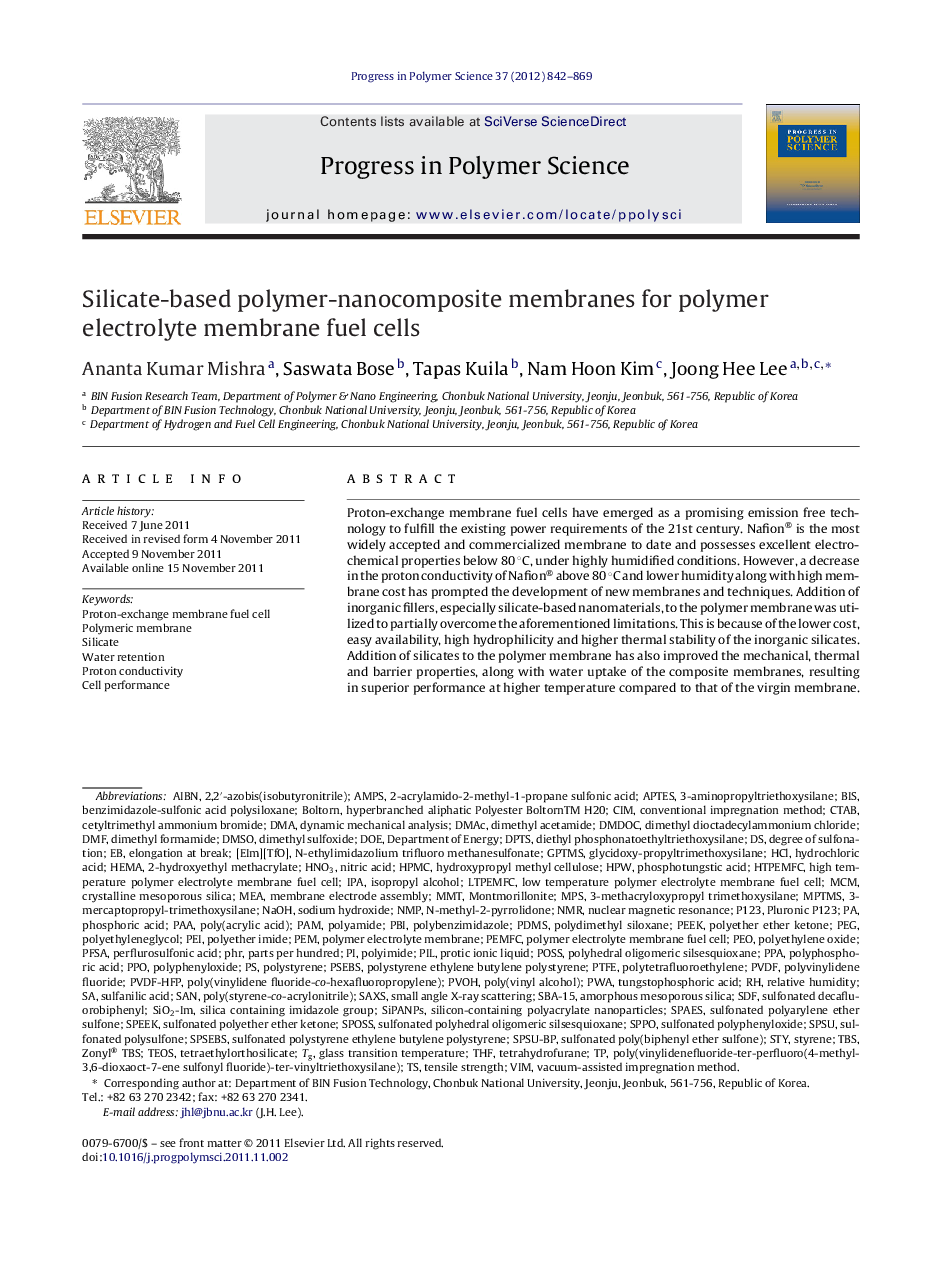| Article ID | Journal | Published Year | Pages | File Type |
|---|---|---|---|---|
| 5208605 | Progress in Polymer Science | 2012 | 28 Pages |
Abstract
Proton-exchange membrane fuel cells have emerged as a promising emission free technology to fulfill the existing power requirements of the 21st century. Nafion® is the most widely accepted and commercialized membrane to date and possesses excellent electrochemical properties below 80 °C, under highly humidified conditions. However, a decrease in the proton conductivity of Nafion® above 80 °C and lower humidity along with high membrane cost has prompted the development of new membranes and techniques. Addition of inorganic fillers, especially silicate-based nanomaterials, to the polymer membrane was utilized to partially overcome the aforementioned limitations. This is because of the lower cost, easy availability, high hydrophilicity and higher thermal stability of the inorganic silicates. Addition of silicates to the polymer membrane has also improved the mechanical, thermal and barrier properties, along with water uptake of the composite membranes, resulting in superior performance at higher temperature compared to that of the virgin membrane. However, the degrees of dispersion and interaction between the organic polymer and inorganic silicates play vital roles in improving the key properties of the membranes. Hence, different techniques and solvent media were used to improve the degrees of nanofiller dispersion and the physico-chemical properties of the membranes. This review focuses mainly on the techniques of silicate-based nanocomposite fabrication and the resulting impact on the membrane properties.
Keywords
PEIDMFHPMCMEATEOSCTABPTFEDOEPDMSPEMFCDMAHClNaOHPVDF-HFPTHFPVDFPEMPAASBA-15PWATBSPAMSDFCIMSTYPPOIPAphrMMTSANPPAPBIMCMAMPsNMPDMAC2-hydroxyethyl methacrylateAIBNHNO3VIMDPTSPOSSN-methyl-2-pyrrolidoneGPTMSHPWSPPOP123Pluronic P1232,2′-azobis(isobutyronitrile)PILPVOHMPTMSSPAESPFSASAXSnuclear magnetic resonance3-aminopropyltriethoxysilaneDMSOsPEEKPolyhedral oligomeric silsesquioxaneTetraethylorthosilicateWater retentionElongation at breakStyreneTensile strengthCetyltrimethyl ammonium bromideTungstophosphoric acidSulfanilic acidPhosphotungstic acidhydrochloric acidPolyphosphoric acidPolyethylene oxideisopropyl alcoholBISTetrahydrofuraneDynamic mechanical analysisNMRDegree of sulfonationglass transition temperaturedimethyl acetamidedimethyl formamideDimethyl sulfoxideRelative humidityPEEKSodium hydroxide, Caustic SodaPolymer electrolyte membrane fuel cellProton-exchange membrane fuel cellhigh temperature polymer electrolyte membrane fuel cellsilicatecell performancePolymer electrolyte membranePolymeric membranePhosphoric acidProtic ionic liquidAPTESMontmorillonitemembrane electrode assemblyMPsNitric acidproton conductivityHEMAHydroxypropyl methyl celluloseDepartment of Energysmall angle X-ray ScatteringPoly(styrene-co-acrylonitrile)Polyamidepolyether ether ketonepolyethyleneglycolpoly(acrylic acid)PolyimidePolybenzimidazolepolytetrafluoroethyleneSulfonated polysulfonePoly(vinyl alcohol)Poly(vinylidene fluoride-co-hexafluoropropylene)Polyvinylidene fluoridepolydimethyl siloxanePEGPolystyrenePEOSulfonated polyether ether ketone
Related Topics
Physical Sciences and Engineering
Chemistry
Organic Chemistry
Authors
Ananta Kumar Mishra, Saswata Bose, Tapas Kuila, Nam Hoon Kim, Joong Hee Lee,
